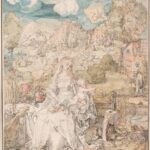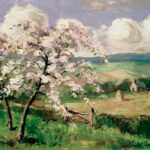They are the glass, a window, but not the ocean.
As I browse a small family-owned workshop in Greece, who handmake icons, I thought that today I can share with you the beautiful spiritual purpose of the icons in Christian Orthodoxy – as I find that their purpose is one we can all learn from and apply its wisdom on heart and soul level in our ordinary every day life.
Beyond the surface of things is the essence of things, and understanding the essence is what allows us an opportunity for a deepening. Regardless of whether you are familiar with Christianity, regardless of whether you are religious or merely interested in theology or history, or perhaps you are an art lover, regardless of your spiritual beliefs, I believe that we gift ourselves an expansionary experience when we learn something new, when we lift the veils and touch the heart of something. Icons are not about the images – they are about the doorways opening our heart. Let’s begin.
Icons are not something that the Christian Orthodox priests, monks and people use to “worship” nor idolize as images – and that’s often misunderstood. Back in the day, thousands of years ago, icons were originally created as a language to portray the stories through images because many people were illiterate. And while they wanted to read and learn the text, they just couldn’t because they couldn’t read, so the stories were told to them through these paintings and iconography.
This might seem silly to some – but I can tell you from experience that when I worked with illiterate women in Africa, as I was creating an educational program for them, I had to get really creative in the way the complex content would be taught in appropriate ways for them. And in that case I used storytelling, as well as exercises they would play out in class – all of which were meant to express the material, teach the knowledge, while also be easily remembered because not everyone in the community knew how to write and read.
When you walk into a church there is a quietness, and spirituality is a quiet thing, inner thing. So you look through the images on the walls and the ceilings, in your quietness and in your stillness, and feelings will be inspired within you, feelings will enter you, and through that you may even enter a new world, a new experience within you, to touch within you that which was veiled before.
And you will go deeper, because essentially you want to touch within you something that will dissolve some of the pre-conditioning of this world, something that will show you how you are beyond what you thought, how there is aliveness beyond what you imagined and is moving through you, how this life is more than what is seen and touched and rationalized, and this will serve your confidence, and this will serve the faith on your path that way.
Father Seraphim Aldea, a Christian Orthodox monk from the Mull Monastery in Europe, described the purpose of icons so beautifully, saying that icons are essentially a place of grace that you can enter – but they are only a gate, a window, a place you enter, they are not God and never have they been worshiped as such.
They are the glass, but they are not the ocean.
This shows us the importance of understanding the essence of things, and the meaning of things, rather than only look at the surface and then discarding it immediately if it doesn’t align with what we currently perceive or understand. And this refers to all of our life.
For scriptures and words also – we need to look deeper into the essence and meaning, otherwise we rob ourselves of deepening in knowledge, learning and we essentially limit our growth. There is no place for literalism in spirituality, and for those of you familiar with reading spiritual and sacred text, such as the Bible, you know how much of it is written in parables. We must first feel it and believe, to then see it – and so the doorway is our open heart, open mind, open palms. When we look beyond the surface of things, we open up new doors – and new worlds, because words become worlds.
And then there’s another higher purpose to the icons: It is the importance of looking at beauty and sacredness because otherwise we forget it.
Icons reminds us of the sacredness of human life, and the goodness and humility of people. Sometimes we forget what beauty is because all we see is shallowness, fakeness and ugliness around. We forget what a natural face looks like because we live in a world of filters, fillers, potions and lotions and artificial images. We forget real human connection and the sacredness of life because we swipe human faces on apps, and say mean things behind screens forgetting that there is a human heart on the other side and we can’t see their human tears on cheeks when we’ve hurt them.
And then we get used to not seeing, not noticing, and unfortunately numbing ourselves to caring. In a world where almost everything is online and we are gaining knowledge from memes because attention spans are less than five minutes, and we prefer not reading and not putting in the effort, and where even art and culture no longer serve to inspire us but to almost dehuminize or disempower us, we’ve become a bit too robotic, a bit too lazy, a bit too ungrateful.
It is important for us to be able to see beauty, nature, human eyes – and whatever that means to you, whatever beauty means to you and whatever sacredness means to you and whatever inspires you through compassion, tenderness and beauty of soul and heart – spend time looking at that. Our minds need it because sight is powerful and shapes us in thoughts, emotions, perceptions, and then habits, behaviours and actions. We can only perceive and see through the windows of our eyes, and if the view is foggy, all will be foggy.
There is a great tenderness in humanness, in our human hands when we hold someone we love, in our human hands when we help and tend to someone or something. There is a tenderness to be remembered in how we create and make things, art and meals, to make someone else’s day a little better, a little more hopeful, and their tummies fuller.
The icons tell of stories – and these are stories of hands, of faithful and loving hands who made them and painted them and gave them to other hands; and these are stories of heart, of the stories of love and humanity – of our interdependence and humanness. These are stories of love, of hope, of faith and of trust – of a graceful place within us that is now opened and softened through the tenderness we see in the image.
The icon above is the Theotokos of Vladimir, or Virgin of Vladimir, which is a 12th-century Byzantine icon depicting the Virgin and Child and an early example of the Eleusa iconographic type. The Eleusa icons are known as the Sweet Kissing or Loving Kindness. This one in particular I really love, as it tenderly depicts the Virgin mother with her child, the infant Jesus, with their cheeks gently touching, as he is nestled against her cheek, and she in his, so lovingly. Eleusa in Greek means “tenderness or showing mercy”, and Eleusa icons are meant to inspire within us these tender and loving feelings.
The Eleusa icons emphasize the role of the mother of Christ, the protector of humanity, and also in general, the role of the mother for all of us as human beings. In Western cultures, these icons are often known as the Virgin of Tenderness. May we all as people be more kind, more gentle, more compassionate – and stay tender in our hearts and skin.
For those of you interested, you may read my article Six Beautiful Insights from a Monk, where I take you on a photographic travel to some of my favourite monasteries in Bulgaria while I share with you the deeper meaning and essence from some of the monastic practices, and how we can apply their spiritual wisdom in practical ways in our modern daily life.
For personal readings with me, you are welcome to browse through my Offerings.

For more of my writings, browse through my Art of Love.
If you wish to support me and my work, you may do so by sharing it or donate here. For personal readings with me, you may visit my Offerings.
Your support means so much to me! Thank you wholeheartedly!



